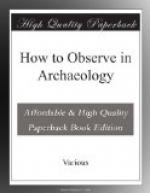[Illustration XII: PALESTINIAN POTTERY TYPES]
VI. Sanctuaries.
The hill-top shrines, now consecrated to saints of Islam, are doubtless in origin ancient Canaanite high places. There is here a rich but a very difficult field for investigation. The difficulty lies in (a) gaining the confidence of those to whom the sanctuaries are holy, and (b) guarding against wilful or unconscious deception. Only long residence and frequent intercourse, with the Muslim population will make it possible for any one to obtain really trustworthy information as to the traditions or the sites of these ancient sanctuaries. A knowledge of Arabic is essential for a study of the sites themselves, as there are frequently inscriptions cut or painted on the walls which should be studied. The casual traveller cannot hope to carry out researches of any value on these ancient sites.
Sometimes the buildings are Crusaders’ churches transformed. The one really certain fact as to masonry dressing in Palestine may here conveniently be noticed—that Crusader structures are built of well-squared stones with a plane surface finished off with a dressing consisting of very fine diagonal lines. Once seen, this masonry dressing is absolutely unmistakable.
Buildings thus identified as Crusader should be examined for masons’ marks.
VII. Miscellaneous.
The following are some other types of ancient remains with which the traveller may meet almost anywhere in Palestine:
(1) Prehistoric (Stone Age) sites. Marked by being strewn with flint implements and chips: see a fine collection in the Museum of the Assumptionists (Notre-Dame de France) at Jerusalem. Specimens should be collected and the site mapped.
(2) Dolmens. Frequent east of Jordan; rare, though not unknown, in Western Palestine. Should be measured, photographed, described, and mapped.
(3) Rock-cuttings of various kinds, which should be
measured, planned, and mapped. Among these the
commonest are:
(a) Cisterns (usually bottle-shaped, a narrow
neck expanding below).
(b) Cup-markings, common everywhere. Often
associated with cisterns.
(c) Wine and olive presses: there is a
great variety in form, but
they generally consist of two essential parts—a
shallow pressing-vat on which the fruit was
crushed, and a deeper receiving-vat in which
the expressed juice was collected. The vats are
often lined with cement containing datable potsherds,
and are sometimes paved with mosaic tesserae. (d)
Quarries.
(4) Sacred trees and bushes, recognized by the rags with which they are festooned. Should be photographed and mapped, and their legends ascertained, subject to the cautions given above under the head of Sanctuaries.
(5) Castles and churches, usually of the Crusader period: early Saracenic buildings. Should be recorded by means of plans, photographs, measured drawings, and written descriptions.




